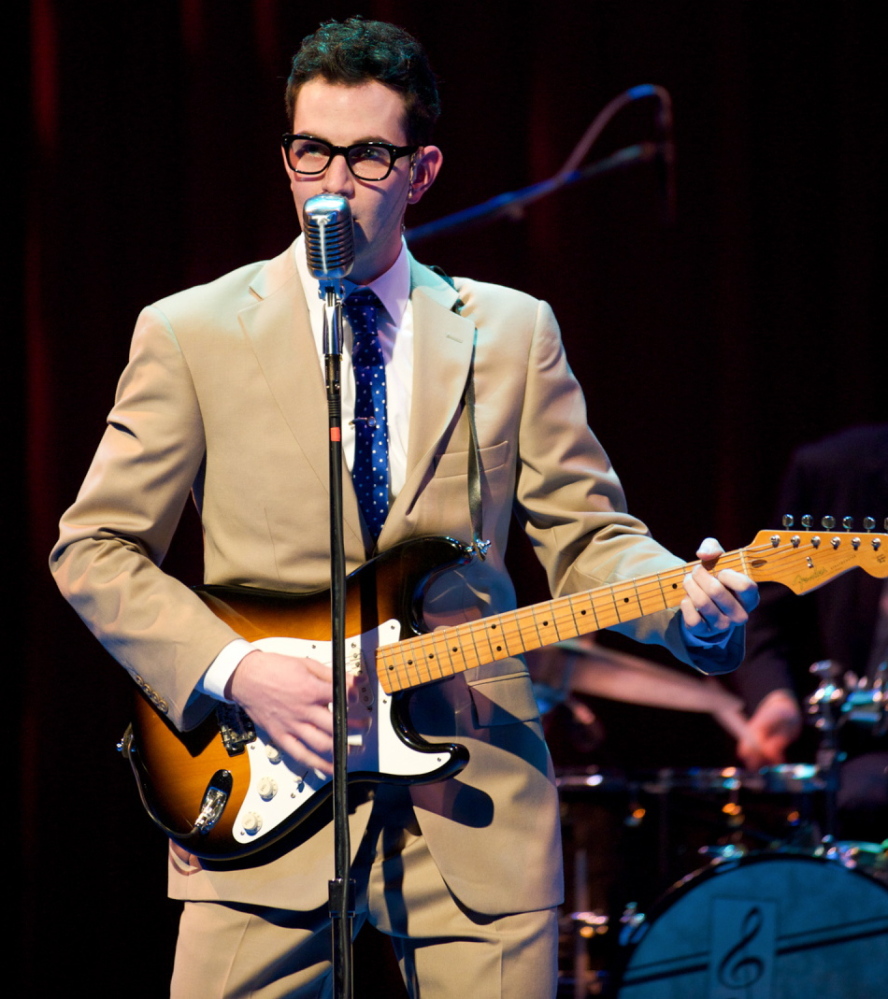Feb. 3, 1959, was famously named “the day the music died” by Don McLean, but Maine State Music Theatre’s “Buddy: The Buddy Holly Story” is exuberant proof that Holly’s music is alive well more than 50 years after his tragic death on that date at age 22.
Largely joyful, often funny and bursting with fabulous Holly renditions, the show opened on Thursday to a packed house at the Pickard Theater on the Bowdoin campus in Brunswick.
“Buddy” is a moving story told with feeling by a talented cast. As Holly, Andy Christopher has a lyrical, gentle presence that becomes electrifying when he starts to rock.
It’s clear from the first trademark hiccup in “That’ll Be the Day,” that Christopher is in love with the songs, which he delivers in a beautiful tenor, paying tribute to Holly without brute impersonation. His dance background is evident in subtle movements at the microphone and smashing rock-star leaps and kicks.
Like many others in this cast, Christopher has an extensive “Buddy” pedigree. He’s played Holly and other roles on national tour and in regional productions ever since his theatrical career took off with a starring role in a “Buddy” production in Holly’s hometown, Lubbock, Texas. Sam Weber, as bassist Joe B. Mauldin, and Joe Cosmo Cogen, as drummer Jerry Allison, have performed together as Crickets (Holly’s band) many times before.
Cogen drives hits including “Not Fade Away,” “Oh Boy” and “Rave On” with power and stylistic precision. On the stand-up bass, Weber is as magnetic for his moves as for his music. Without missing a beat, he plays the huge instrument over his head and behind his back, stands on it (as does Christopher in one of the show’s iconic images) and sits down to rest humorously when the bass line slows down.
Weber is a good example of how well these players keep the show fresh. At every turn, he seems to be saying, “This is so cool!” as if it were the first time he’d heard each musical twist.
The “Buddy” storyline is sometimes considered thin, but the dramatic movement is actually quite effective, if minimalistic. The story begins with Holly’s arguments with Lubbock radio deejay Hipockets Duncan, played by Steve Gagliastro, a brusquely affectionate father figure who objects to Holly’s insistence on playing rock and roll but gets him a recording contract nonetheless.
After rejection by Nashville’s Decca Recording Studios for insisting on his own style, Holly moves on to the smaller studio of Norman Petty (Luke Darnell) in Clovis, New Mexico.
Here, the show traces the development of songs including “Peggy Sue” (changed from “Cindy Lou” to impress Allison’s girlfriend). As Vi Petty, Lori Eure chimes in with bluesy piano for “Mailman Bring Me No More Blues” and with the celeste in “Everyday,” showing how the latter got its famously delicate sound.
With Holly’s recording success comes a concert at Harlem’s Apollo Theater, where he and the Crickets are assumed to be black, based on their sound. The show plays up this racial mix-up, almost too much, but with humor that feeds the triumph when the audience accepts the band despite skepticism (and some fear) on both sides.
As Apollo performers, saxophonist Troy Valjean Rucker and vocalist Jayne Trinette are both superb. Trinette’s voice is wonderfully true and rich even in the most loudly belted notes of “Shout.”
The entire cast comes together as an onstage band for Holly’s final concert at Clear Lake, Iowa. Holly is joined by Ritchie Valens (Xander Chauncey) and J.P. “The Big Bopper” Richardson (Jayson Elliot), who both died with him. Here, the show goes wild, on stage and in the audience.
Chauncey delivers a rousing, hip-swiveling “La Bamba.” Elliot’s “Chantilly Lace” is simply huge; there’s an incredible amount of spirit in his simple, marching dance steps, glowing face and total absorption.
Director Donna Drake has chosen not to overplay the pathos, making a fairly short transition from the main concert to the post-crash “encores.” She also foreshadows the event effectively by starting the show with a glimpse of Clear Lake, stitched conceptually to the climax by the shared song “Rave On.”
In another change to the opening, Drake has turned the country songs of “The Hayriders” into a pre-curtain show, that is worth arriving early for. This is rather effective, allowing the Holly-centered energy to take off immediately when the curtain opens.
Jennifer Brewer of Saco is a freelance writer, teacher, musician and dancer.
Send questions/comments to the editors.



Success. Please wait for the page to reload. If the page does not reload within 5 seconds, please refresh the page.
Enter your email and password to access comments.
Hi, to comment on stories you must . This profile is in addition to your subscription and website login.
Already have a commenting profile? .
Invalid username/password.
Please check your email to confirm and complete your registration.
Only subscribers are eligible to post comments. Please subscribe or login first for digital access. Here’s why.
Use the form below to reset your password. When you've submitted your account email, we will send an email with a reset code.